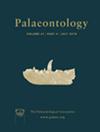寒武纪和奥陶纪棘皮动物辐射初期的生态新特征
IF 2.3
2区 地球科学
Q1 PALEONTOLOGY
引用次数: 0
摘要
寒武纪和奥陶纪的辐射标志着所有主要棘皮动物支系的起源,并确立了它们在新生代的生态蓝图。最近关于早期棘皮动物和其他动物创新不多的说法表明,新颖性在门类起源过程中受到限制。在这里,我们记录了366个寒武纪-奥陶纪棘皮动物属的丰富生活习性、体型、分层、栖息地利用、移动性、饮食和觅食习性,并进行了时间尺度的系统发育,以确定创新的时间和影响。大多数早期棘皮动物都是定居的滤食性微型食肉动物,尽管分类组成发生了很大的变化,但它们的体型、食物和运动方式在很大程度上没有随着时间的推移而改变。寒武纪的棘皮动物生活在靠近海底的地方,其中花叶棘皮动物首先演化出半隐居的生活方式。许多奥陶纪棘皮动物生活在离海底较远的地方,具有更复杂的滤食器官和分层结构,通常使用其他生物作为基质。移动的肉食动物和大量进食者也在那时出现,遍及各种星虫和棘皮动物。这些新生物大多出现在寒武纪早期和晚期(特雷努纪/第二系和古龙纪),个别类群的起源与此相吻合,大多数类群经过 1,000 万至 2,000 万年后才成为具有重要生态意义的类群。大多数类群的生活习性演化都涉及到这些特征的新变化,其中板岩类和小行星类能够更好地转变策略。奥陶纪辐射记录的更多是寒武纪以前存在的生活习性的新变异,而不是彻底的重新发明,重要的新特征(如移动式肉食和大量取食、离海底高度增加和生物基质)对生态的影响更大。具有这些策略的类群最有能力利用新出现的奥陶纪异质世界。本文章由计算机程序翻译,如有差异,请以英文原文为准。
Ecological novelty at the start of the Cambrian and Ordovician radiations of echinoderms
The Cambrian and Ordovician radiations marked the origins of all major echinoderm clades and established their Phanerozoic ecological blueprint. Recent claims of modest innovation of early echinoderms and other animals suggest constraints on novelty during the origins of phyla. Here, we document the life-habit richness, body size, tiering, habitat usage, mobility, diet and foraging habits of 366 Cambrian–Ordovician echinoderm genera across a time-scaled phylogeny to identify the timing and impact of novelty. Most early echinoderms were sedentary, filter-feeding microbivores, and their body sizes, diets and modes of locomotion were largely unchanged through time, despite major volatility in taxonomic composition. Cambrian echinoderms lived close to the seafloor, with stylophorans first evolving semi-infaunality. Many Ordovician echinoderms lived farther from the seafloor, with more complex filter-feeding organs and tiering structure, often using other organisms as substrates. Mobile carnivores and mass-feeders emerge then, too, across diverse asterozoans and echinozoans. Most of these novelties coincide with the origins of individual clades during the early and late Cambrian (Terreneuvian/Series 2 and Furongian), and 10–20 million years pass before most become ecologically important. Life-habit evolution within most taxa involved new variations in these traits, with crinoids and asterozoans better able to shift strategies. The Ordovician radiation records more new variability in pre-existing Cambrian life habits rather than radical re-invention, with important novelties (like mobile carnivory and mass-feeding, increased height off the seafloor, and biotic substrates) becoming ecologically more impactful. Taxa with these strategies were those best able to capitalize on the newly heterogeneous Ordovician world.
求助全文
通过发布文献求助,成功后即可免费获取论文全文。
去求助
来源期刊

Palaeontology
地学-古生物学
CiteScore
5.60
自引率
3.80%
发文量
43
审稿时长
6 months
期刊介绍:
Palaeontology publishes a wide variety of papers on palaeontological topics covering:
palaeozoology
palaeobotany
systematic studies
palaeoecology
micropalaeontology
palaeobiogeography
functional morphology
stratigraphy
taxonomy
taphonomy
palaeoenvironmental reconstruction
palaeoclimate analysis and biomineralization studies.
 求助内容:
求助内容: 应助结果提醒方式:
应助结果提醒方式:


